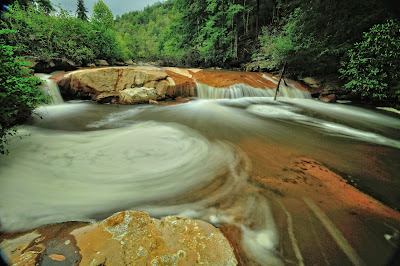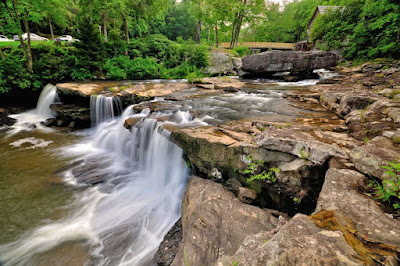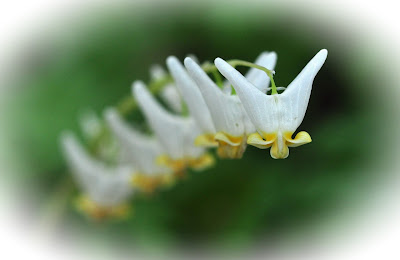Can you
imagine a West Virginia State Park about 80 miles long and only 100 feet wide?
If so, then you have pictured the Greenbrier River Trail State Park, which has
the distinction of being both the longest and the skinniest State Park in West
Virginia. It is long and skinny because it is a former railroad bed that has
been converted into a trail. Previously part of the Greenbrier Division of the
Chesapeake and Ohio Railway (C&O), trains carried freight and passengers
along the banks of the Greenbrier River in Pocahontas and Greenbrier Counties for
nearly 80 years. But when the line became unprofitable in the 1970s, C&O eventually
donated the corridor to the state in 1978. By 1980 the old railroad bed had
been authorized by the State Legislature for public use as a rail trail
according to Jody Spencer, Park Superintendent. Gail Hyer of the Pocahontas County
Convention and Visitors Bureau noted that the trail suffered damage in the
flood of 1985 that wasn’t fully repaired until 1994. More damage occurred in
the flood of 1996 that took three years of restoration. The flood of June 2016
also damaged the trail. Repairs are now underway, and the trail is gradually
being restored.
 |
| Pocahontas Conv. Bureau |
Nationally Recognized
Despite the
setbacks, the Greenbrier River Trail (GRT) has not only survived; it has thrived.
Today the GRT is one of West Virginia’s most successful and popular
rail-to-trail conversions. Backpacker Magazine ranked the GRT as one of the top
ten hiking trails in the United States. Moreover in October 1999, the GRT
became one of 50 of the Nation’s Millennium Legacy Trails. Selected from
nominations by the governors of the United States and its Territories, these
trails reflect the essence and spirit of our nation.
 |
| Pocahontas Conv. Bureau |
A Recreation Gateway
Running 80
miles down the spine of the Allegheny Highlands of West Virginia, the GRT sports
unique recreational opportunities in the State. The trail traverses 30 bridges
and two tunnels and is a gateway to some of West Virginia’s most refreshing
scenery. The trail
passes through the Monongahela National Forest; Cass, Watoga, and Droop
Mountain State Parks; and Greenbrier and Seneca State Forests. With 19 trailheads scattered along its length,
the trail can be broken into dozens of short hikes, either round trip or one
way. There are a few primitive campsites along the trail, for those who want to
take a few days and traverse the entire length. Sources of drinking water and
toilets are scattered along the route, as are grocery stops. Lodging at State
Parks, local motels,
privately-owned cottages, and bed and breakfasts is also available along the
trail. It is little wonder that the trail is busy with bikers, hikers and
horseback riders. As GRT follows the banks of the Greenbrier River through
rural Greenbrier and Pocahontas Counties, the river meanders in a wide,
shallow, gravel-lined bed that comforts the eye and in summer, invites fishing,
wading, canoeing and paddle-boarding. The trail surface is primarily ¼” crushed
limestone and electric-powered chairs and scooters are permitted for disabled
use only.
 |
| Photo by Drema Morgan |
But Wait, There’s More!
The GRT is
undoubtedly one of the best hiking and biking venues in West Virginia. But a
closer look at the GRT reveals that there’s much more to being a traveler along
this long and winding road through our State. For my wife, Phyllis, and me the
main attraction is wildflowers. From the first bloodroot of spring to that last
blossom of fall, we search the state for wildflowers and their hang-outs. The
New River Gorge is a haven for spring wildflowers, but by summer we turn our
attention elsewhere to maintain the hunt. Last July, on a tip by our friend
Drema Morgan, a WV South writer and photographer, we headed out to the GRT. She
reported seeing a Turk’s cap lily on the southern end of the trail. That was
enough to send Phyllis and me out the door and down the road. After downloading
a trail map, we decided to start at the North Caldwell trailhead at milepost 3.
From Beckley it was an easy drive on I-64 East to Exit 169 at Lewisburg. From
there we drove north on US 219 for ½ mile, turned east onto Brush Road (Rt.
30), then, after ½ mile, continued onto Stone House Road (Rt. 38) for another
three miles to the trailhead.
 |
| Turk's Cap Lilies |
My next blog
will have more about wildflowers on the GRT. Click here.





















































